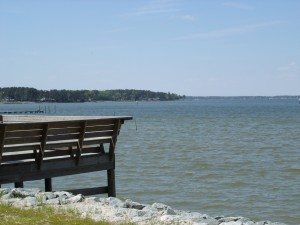Each impaired shellfish area has unique challenges, so this post is only about Queens Creek, which is listed in the 2007 Gwynn’s Island-Milford Haven watershed TMDL report. It states “septic systems should be a primary implementation focus because of health implications….” Like many official statements, it sounds good at first hearing, but if septic systems are failing near Queens Creek, why would the human contamination drop to 0% on any month’s reading, much less for 3 of 6 readings taken between October, 2005 to August, 2006? But Figure 4.6 B shows 74% for the average annual fecal coliform contributions from wildlife.
Residents on Queens Creek have seen the geese population go from staying half the year to settling in year-round. Does that have anything to do with the high wildlife contributions? Can’t tell from the reports because the details aren’t provided, only totals and percentages for ‘wildlife’.
Other questions are, “Do the geese increase the phosphorus load too? Are they causing any additional shoreline erosion by eating young shoots?”
But as things stand, continual contamination means the waters have no possibility of recovery naturally, so what happens to the areas further downstream?
The report acknowledges that for some areas, “water quality modeling indicates after removal of all of the sources of bacteria (other than wildlife), the stream will not attain standards under all flow regimes at all times. However, neither the Commonwealth of Virginia, nor EPA is proposing the elimination of wildlife to allow for the attainment of water quality standards….The reduction of wildlife or changing a natural background condition is not the intended goal of a TMDL.”
What is their plan? Even if all the effluent, pet and livestock elements are reduced as far as humanly possible, according to the 2007 report, the bottom line is the state agencies don’t plan to do anything–except change the assigned use of the waters–probably permanently.
It’s relatively easy for TMDL plans to go after the obvious 8% human element, 9% livestock and 9% pet contamination the state tests indicate. It’s not going to be easy to deal with the rising population of geese, but information is available about how to address the problem. Now we have to see if our state agencies are going to go beyond the obvious and deal with the 74% of bacterial contamination attributable to wildlife. Wonder if we’ll find out on the 23rd.



You know, this site is worth visiting if only for the photos! I love Davie’s sunset picture! I often think of Rand Paul asking why we have to have think mandates are the only solution to problems. What if people were just made aware of the problem and asked to do what they can to help solve the problem? Think of all the people who recycle paper, plastic and glass just because they know it is the right thing to do. Maybe we can just encourage people to put their pets poop in their toilet or trash to keep it out of the streams. Maybe we can just teach or demonstrate other good earth practices and ask people to consider the consequences & see what happens. http://www.youtube.com/watch?v=ELDHaeEsNF0
Thanks! Yes, that photo is outstanding. I hope we get a good turnout for the meeting. If we know what the problem is, we’ve got a lot of smart citizens with life experience, military experience and just plain common sense who could help with the solutions as long as we get accurate info in the first place from the various agencies.